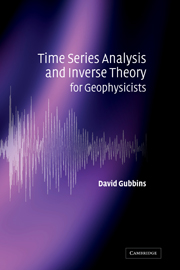Book contents
- Frontmatter
- Contents
- Preface
- Acknowledgements
- List of illustrations
- 1 Introduction
- Part I Processing
- 2 Mathematical preliminaries: the z-and discrete Fourier transforms
- 3 Practical estimation of spectra
- 4 Processing of time sequences
- 5 Processing two-dimensional data
- Part II Inversion
- Part III Applications
- Appendix 1 Fourier series
- Appendix 2 The Fourier integral transform
- Appendix 3 Shannon's sampling theorem
- Appendix 4 Linear algebra
- Appendix 5 Vector spaces and the function space
- Appendix 6 Lagrange multipliers and penalty parameters
- Appendix 7 Files for the computer exercises
- References
- Index
4 - Processing of time sequences
Published online by Cambridge University Press: 05 June 2012
- Frontmatter
- Contents
- Preface
- Acknowledgements
- List of illustrations
- 1 Introduction
- Part I Processing
- 2 Mathematical preliminaries: the z-and discrete Fourier transforms
- 3 Practical estimation of spectra
- 4 Processing of time sequences
- 5 Processing two-dimensional data
- Part II Inversion
- Part III Applications
- Appendix 1 Fourier series
- Appendix 2 The Fourier integral transform
- Appendix 3 Shannon's sampling theorem
- Appendix 4 Linear algebra
- Appendix 5 Vector spaces and the function space
- Appendix 6 Lagrange multipliers and penalty parameters
- Appendix 7 Files for the computer exercises
- References
- Index
Summary
Filtering
Filtering of a time sequence is convolution with a second, usually shorter, sequence. Many important linear processes take the form of a convolution; for example the seismometer convolves the ground motion with its own impulse response, and can therefore be thought of as a filtering operation. We shall concentrate on bandpass filters, which are designed to eliminate whole ranges of frequencies from the signal. Filters that eliminate all frequencies above a certain value are called low-pass while those eliminating all frequencies below a certain value are called high-pass. A notch filter removes all frequencies within a certain band. The range of frequencies allowed through is called the pass band and the critical frequencies are called cut-off frequencies. These filters are particularly useful when signal and noise have different frequency characteristics.
An example of filtering is shown in Figure 4.1. Exactly the same seismogram shown in Figure 1.1 has been high-pass filtered to remove energy at frequencies below 1 Hz. This removes large surface waves to reveal body waves. Surface waves have typical periods of 20 s while body waves have much shorter periods of about 1 s, so they are quite widely separated in frequency. An aftershock is concealed in the surface waves generated by the main event. A high-pass filter does a good job of removing surface waves from the record, leaving the body waves from the aftershock unchanged.
- Type
- Chapter
- Information
- Publisher: Cambridge University PressPrint publication year: 2004



